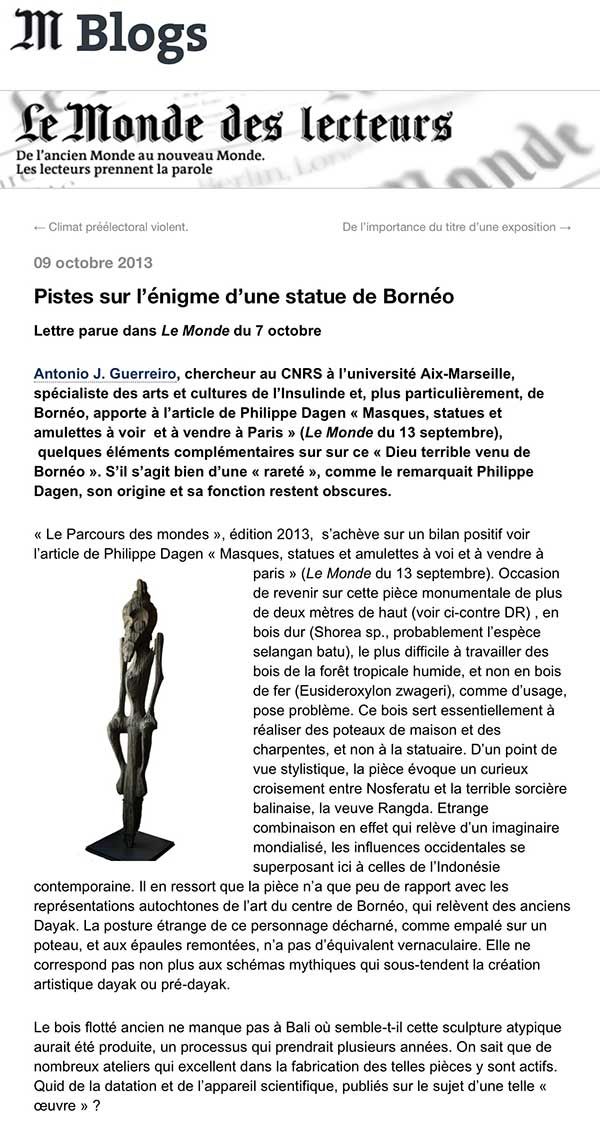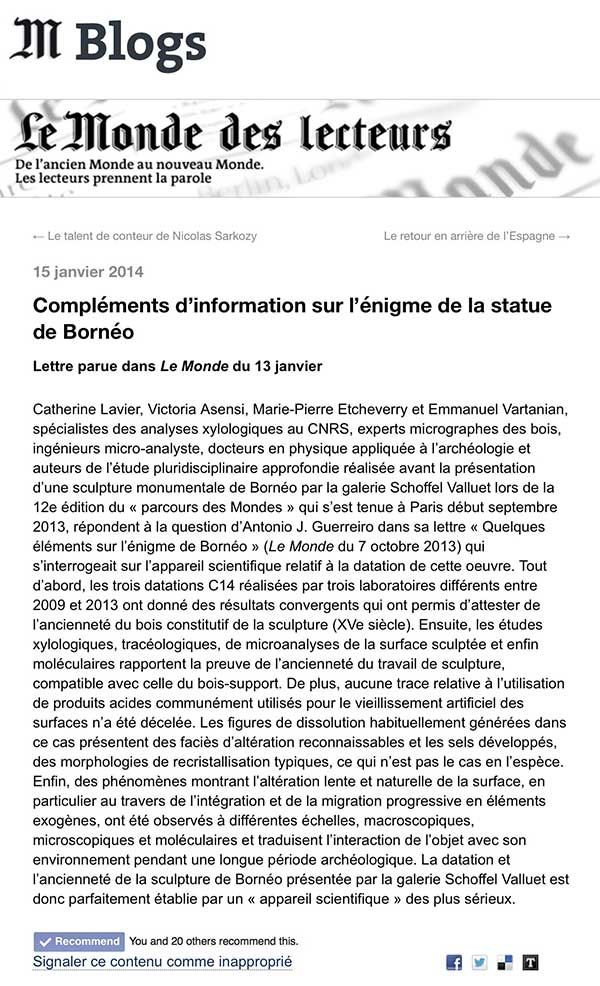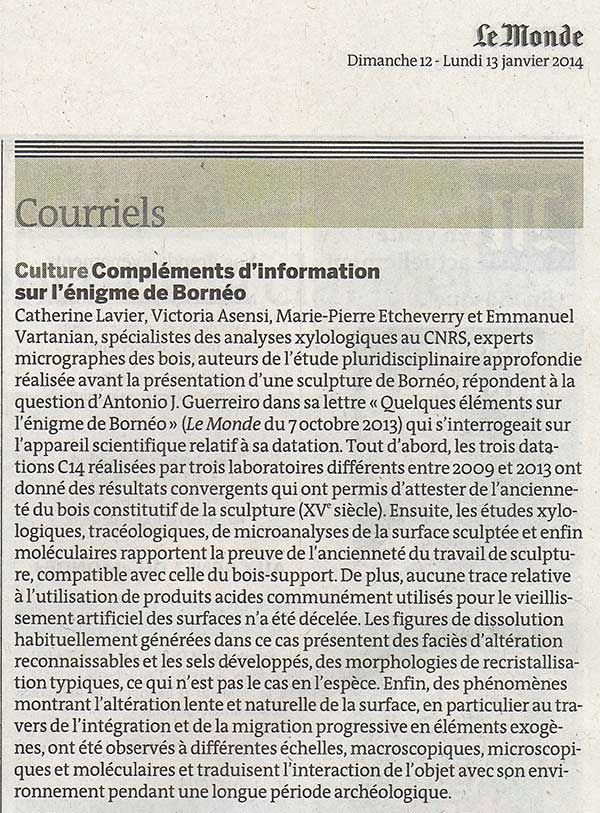TALE OF A SCULPTURE IN PARIS
« By disparaging an authentic work of art or artifact, they are essentially thieves stealing the history of the art and from the culture that made it.» Mark Johnson.
Although I have been collecting tribal art objects for years, I do not have the soul of a collector. I like to live with the collected objects for a few months, even a few years but I experience a lot of pleasure when one of them goes away to join another collection. Therefore, it seems to me a natural thing for a masterpiece to pursue its course. This statue was not pulled out of a river’s silt after several centuries of sleep preceded by a few decades of ritual use only to be admired by a few friends during a diner. No! This sculpture is born from the spirit and the work of a great Dayak artist. “She” is the image of a long disappeared human group, the sole testimony of its existence on earth, like a blast of humanity emerging from the past. Her destiny must be accomplished and only a renowned collection is in measure of welcoming her. It was during a conversation with Alain Schoffel that I suggested to present her at “Parcours des Mondes”. Judith Schoffel and Christophe de Fabry were very passionate about that idea. The events succeeded one after the other very quickly. We were mid-June and we had to move swiftly. A new C14 dating is done. A beautiful base was made. A photographer shoots her like a star, a book relating this scientific adventure is edited by the gallery and a press-kit is sent mid-July to Tribal Art Magazine. We are all looking forward to “Parcours des Mondes’” opening. Summer 2013 is sunny. Friday preceding the opening of “Parcours des Mondes”, I am invited by Matthieu Vidard at his scientific broadcast on “France Inter”, in the emission called “La Tête au Carré”, so as to present the entire scientific analysis and their conclusions which retrace the physical history of this sculpture from its being cut down as a tree to its emersion in a Borneo river. Everything goes … too well?

LEFT TO RIGHT. THE BOOK EDITED BY THE GALLERY schoffel VALLUET with THE DESCRIPTION OF ANALYSES AND THEIR RESULTS. AD-PRESS PUBLISHED IN TRIBAL ART MAGAZINE, No. 69, autumn 2013. Podcast "La Tête au Carré" September 6, 2013. Copyright galerie Schoffel Valluet, Bertrand Claude, J-F Chavannes, France-Inter.
A Lynching in Paris : Mob Mentality condemns Borneo Sculpture in Parcours Kangaroo Court.
- Title of the article published by Mark Johnson on his blog "the tribal beat", october 2013 -
From the Sunday morning preceding the opening of this fair, Judith has to face the “vetting” brought in by Steve Alpert, an American merchant, in presence of the fair’s organizer, Pierre Mood, and of Tribal Art Magazine’s artistic director, Alex Arthur. The accusation they make is very serious. According to them, it is a fake! Dismissing all the scientific proofs, the members of this “jury” brutally assault the owner of the gallery who defended herself alone against these hounds. We are far off from the cozy environment of galleries, and further away from a gentlemen’s agreement, and nearer to a rat race. Concerning the technical arguments developed by the vetting members to hold their charge, arguments which were repeated over and over again by a certain amount of petty-minded art dealers and collectors, I am publishing Mark Johnson’s article which was published on his blog a few weeks after this happening and the eloquent title of which is “Lynch law in Paris: a gang condemns a Borneo sculpture during Parcours des Mondes”. Note that contrary to the fair’s regulations, the sculpture will not be removed from the exposition. At the opening on Tuesday the 10th of September, the public’s enthusiasm for this master piece is tremendous despite the rumors which are running from café terraces to restaurant rooms, from sidewalks to sidewalks, from a gallery to another. It runs, it runs, the ferret…!
this sculpture was bought by an American merchant, in Bali, for a few thousand dollars and resold to Alain Schoffel a few months after for another handful of thousands of dollars.
I have to mention here the craziest of them all because it reveals how jealousy and vanity can generate the most vile stupidity. According to a comment published by Mathieu Soulas on a Belgium blog, which was not suppressed by the administrator responsible of the publication, and that makes him a partner in crime, this sculpture was bought by an American merchant, in Bali, for a few thousand dollars and resold to Alain Schoffel a few months after for another handful of thousands of dollars (this looks much like a western spaghetti!), and who not being able to sell it in turn, had tried to sell it to “Parcours des Mondes” for an astronomical amount (sic!). Beyond the fact that this lie is an insult to Alain Schoffel’s probity and experience (more than 50 years in this job), to imagine that he could transfer his responsibility onto his daughter, Judith, and have her bear it so as to be able to sell of a “fake” during a tribal art happening, where art dealers, collectors and curators from all over the world meet, is at best coming from an ill-minded spirit, and at worst from an imagination needing a psychiatric diagnostic. As you have discovered it before while reading my article “Trip to the heart of the wood”, Alain Schoffel discovered this sculpture in 2012, at my home, in Paris four years after her being taken out of a river in Borneo. And, to be franc, he would have loved to buy it for a hand full of dollars, and so would I, anyway!

One of the rumors reported on a Belgian blog by Mathieu Soulas. The Schoffel Valluet gallery got a few months later withdraw this comment because the content is defamatory.
Bruce Carpenter’s ears rang so much that he published a fiery article on Pierre Nachbaur’s blog, the title of which was “Tribal Turf Wars – “Parcours des Mondes” 2013 –“ to explain his point of view about this cabal, conspiracy, plot.
I find it useful to precise that the Quay Branly’s museum does not appeal to external experts for their purchasing and that they have at their disposition the C2RMF to proceed to scientific analysis if needed. Another rumor which is remarkable of stupidity was born in a little corner of the book edited by le Schoffel Valluet Gallery, “The unveiled life of a master piece from Borneo”. On the second cover-sheet, top left, it is mentioned “B.C. collection”. Those initials are going to provoke among those who are leading the plot a real manhunt. Everybody wanted to know who was hiding behind those initials. Everybody wanted to know who was the owner. Can’t be a Hercule Poirot just by wishing to be one! A few clever ones pointed out Bruce Carpenter, a well-known personality in Bali. And of course, the crows from all over the world ate the cheese. Bruce Carpenter’s ears rang so much that he published a fiery article on Pierre Nachbaur’s blog, the title of which was “Tribal Turf Wars – “Parcours des Mondes” 2013 –“ to explain his point of view about this cabal, conspiracy, plot. Because all these “cow-boys” according to Bruce Carpenter’s words, have pretended to be sheriffs, shooting in every direction without knowing how to hold a gun – to hell innocent victims, everybody is guilty! – instead of looking peacefully at the piece of art presented, instead of reading the scientific analysis accounts and to think by themselves.
Left to right. Letter from Mr Guerreiro published in Le Monde on October 7, 2013 and on this blog daily on October 9. The scientific answer published in Le Monde on Sunday, January 12, 2014 and January 15 on the blog.
the main species used by the Dayak are sorted hard, semi-hard and soft. The first category includes Ulin, Menggeris, Selangan batu (Shorea sp.) and Merang, all used for architecture and sculpture
- Patong, la grande sculpture dei populi del Borneo, page 78. Antonio Guerreiro. 2008 -
But the crowning piece is to be found in the archives of the blog “Le Monde des Lecteurs” (The readers’ world). One of them, Antonio Guerreiro, wrote to an evening newspaper to answer Philippe Dagen’s article explaining “Parcours des Mondes”, and published a few days before. In it, he claims that the wood used, Shorea sp., is not used in Borneo to carve sculptures, contrarily to what he writes in “Patong the great sculpture dei populi del Borneo”, page 78, when he gives this precision, I am quoting him: “the main species used by the dayaks are classified in the hard, semi-hard and soft ones. The first type includes the Ulin, the Menggeris, the Selangan batu and the Merang, all used in architecture and for sculptures”. Where is the consistency in all this? Further on, this man analyses more deeply that, in a stylish point of view, this sculpture “makes one think a strange mix of Nosferatu and a terrible witch from Bali, Rangda” and that it comes from “a generic world-wide imagination”. Here, I am sending back the reader to what Bruce Carpenter thinks of this idea, mainly eccentric. Still further on, this distinguished expert of Indonesian culture maintains that “… this unconventional sculpture was realized in Bali from floated wood, … a process which would take several years… within one of the many woodworking workshops which excel in the making of such pieces”. Having lived in Indonesia, in Bali, I can assert that this idea is one of the most common myths I have ever met, and that nobody has ever seen any of those workshops because they do not exist. And to end this batch of snap informations and reveal his great spirit, this man queries the quality of the work done by scientists by writing: “what about the dating and the scientific work published concerning such a piece of art?”. Without a doubt, this researcher is making a big deal about CNRS scientists’ honesty and the ability. These will appreciate this. As for those who have worked on this project, they have answered him in this same newspaper. ( voir ci-dessus).
To summarize all these stupidities, I will quote a short tale of Jean de la Fontaine: (1621-1695):
A fox, which some say Gascony others say Norman,
was almost with hunger dying,
Some grapes on a trellis spying,
To all appearance ripe, clad in.
Their tempting russet skin,
Most gladly would have eat them;
But since he could not get them,
So far above his reach the vine
“They’re unripe,” he said; “such grapes as these,
The dogs may eat them if they please!”
Did he not better than to whine?
Everyone now knows the real story of this discovery, and its course from a river in Borneo to the showcases of Saint-Germain-des-Près. Everything that is said here are real documented facts. The comedy which was played that year during “Parcours des Mondes” by some actors of the Tribal Art Market is a cruel lack of respect and curiosity in front of a piece of art which is questioning, challenging, and not at all alike the enthusiasm of the visitors of that happening. The dark side of human nature has been unleashed against people of good faith and an extraordinary sculpture. The Tribal Art Market’s rags have been torn by those who wear them without noticing one moment that by doing so, they have unveiled their dyeing souls and their lost spirits for all to see.
I am leaving the conclusion of this tale to Mark Johnson whose honesty and passion for Borneo’s art have not been caught red-handed in the midst of this violent and despiteful tempest of rage and jealousy and who ends his article as follows in his blog:
By disparaging an authentic work of art or artifact, they are essentially thieves stealing the history of the art and from the culture that made it.
1. Vetting: In antique demonstrations, panel of experts to monitor the quality of the documents presented before the public opening. These are regularly treated with caution as they are not generally composed of neutral personalities devoid of interest. The member of the vetting of this Parcours des Mondes 2013 are : Steve Alpert, Pierre Amrouche, Johan Levy and Edward Klejman, accompanied by Alex Arthur Tribal Art Magazine and Pierre Moos, president of Parcours des Mondes.
2. In his letter to Le Monde, Antonio Guerreiro wrote: "... this monumental work of more than two meters high, hardwood (Shorea sp, probably the species Selangan Batu.) the most difficult to work of wood rainforest, and not by ironwood (Eusiredoxylon zwageri), as usual, is problematic. This wood is used primarily for making house posts and frames, not statuary.


